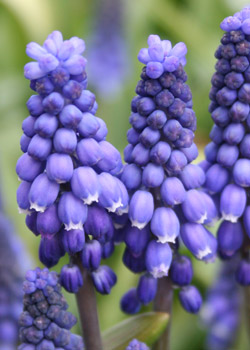Muscari Bulbs Information

Cultivated at the beginning of 1576 in England, muscari (or grape hyacinth) is a plant that has stood the test of time! There are over forty species of muscari plants which all produce spikes of flowers, resembling bunches of grapes. Muscari are very easy to grow and bloom in early to mid-spring, depending on the species. Their lovely blooms range in color from blue, purple, to white and grow well in rock gardens, borders, and under other taller spring-blooming bulb plants, such as tulips and daffodils. Rodents and deer tend to shun this plant, making these flowers great for naturalizing along the edges of wooded areas!
Plant Information
- Planting Time: Fall
- Bloom Time: Mid Spring
- Hardiness Zone: 3-8
- Suitable Zone: 3-9
- Light Needs: Full Sun
Planting Muscari
- Muscari are typically planted in fall. Their roots will form in fall and they will bloom in early to mid-spring.
- Muscari is a durable plant and will grow in most locations but prefers cool, moist soil. Try to choose a planting location that receives at least a half day of sun and has well-drained soil.
- Muscari work well for naturalizing a large area. To attain this look, simply map out an area you would like to naturalize and dig the entire area about 2-3" deep. Scatter the bulbs throughout the area for a natural look. If you desire to evenly space them for a garden border, space them approx. 2" apart or plant in odd numbered groups.
- Plant muscari approx. 2" below the soil surface with the more pointed side of the bulb facing upwards. It can be somewhat difficult to determine which end of a Muscari bulb is "up". If you are unsure of which side is up, plant with the flattest side down.
- Thoroughly soak the area with water once all the bulbs have been planted. Water as needed while the plant is growing and blooming.
- After the flowers have died, allow the remaining foliage to yellow and die back. The leaves will continue to gather sunlight and make food for next year's blooms.
- Once the foliage has yellowed and dried, it may be removed by gently pulling it out of the soil. If the leaves do not easily pull away from the bulb, they are not ready to be removed. After the foliage has been removed, your muscari will be dormant and ready to "rest" until next year!